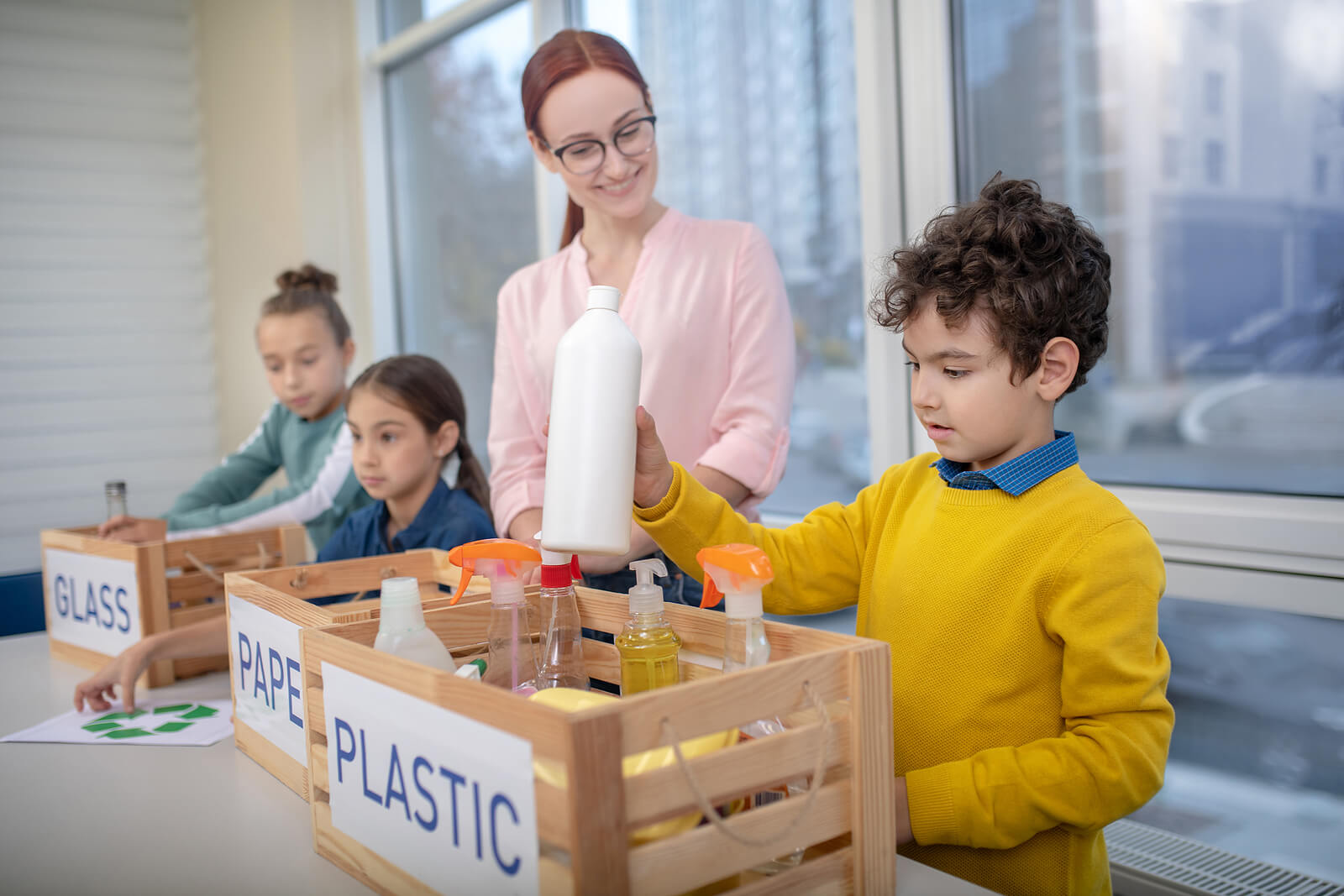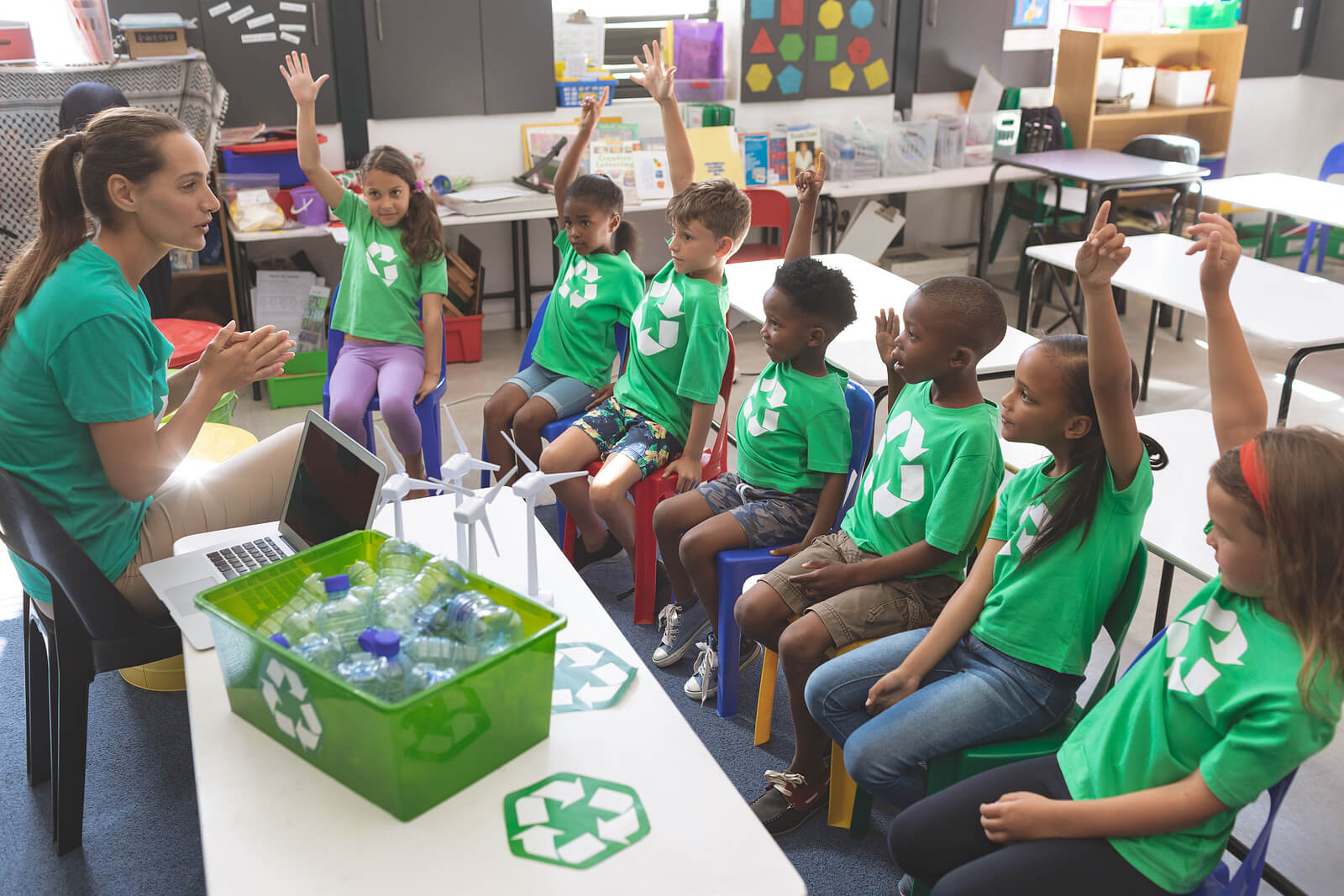Educating children from an early age is key when it comes to positive recycling habits. A significant part of childhood is spent in schools or educational establishments, so it’s important that teachers and other members of staff set good examples to pupils.
Telling children what to do isn’t always enough, so it makes perfect sense to make them environmentally aware by demonstrating what positive recycling habits look like.
Instilling these habits while they are young means they will last a lifetime and lead them down a greener path. It can even inspire families at home to take action when it comes to saving the planet.
How does recycling help the environment?
Recycling is a gift that keeps (and will keep) giving to our environment. Many items, from clothes to drink cans and aerosols can now be recycled, so by raising awareness of what can be recycled and establishing recycling as a norm, we as a society and planet can reap the benefits.
According to WRAP (Waste & Resources Action Programme), almost nine in ten (88%) UK households say they ‘regularly recycle’, which helps to cut down on landfill and conserve our natural resources.
When we recycle, we lessen disruption to the natural world, protect animal habitats, and reduce the amount of greenhouse gases produced when new materials are created. This underlines the importance of recycling as it helps us eliminate large volumes of waste — one of the major causes of global warming and pollution.
How much waste do schools produce?
In the 2020/21 academic year, there were over 32,000 schools in the UK, all with a vital role in helping reduce waste and educating children about the importance of recycling.
According to Recycle Now, the average UK primary school produces 45kg of waste per pupil every year. Both students and teachers can work collaboratively to identify what materials can be recycled instead of being thrown away.
There is an incredible amount of recycling potential in schools, which can in-turn help them save money in collection charges, as well as create a positive image for the parents of prospective pupils.
Whether it’s cutting down on paper waste in the classroom, thinking about the packaging in their packed lunches or correctly disposing of electronic devices, children should be encouraged to contribute to their school’s recycling efforts. Recycling one tonne of printing paper, for example, can help to save 24 trees from being cut down.
Recycling in school statistics
There are four common types of waste found in schools: paper, food, plastic, and electronics. Paper is the main form of waste created by schools, accounting for a quarter of all rubbish.
An estimated 78% of school waste is recyclable or compostable, which is why even more can be done to inspire future generations to be conscientious and help oust some of the below statistics that illustrate schools are still producing tremendous amounts of waste.
- The average primary school student generates around 45kg of paper waste in the UK per year.
- An estimated one million paper sheets per school are used annually for printing. With the use of paper comes the use of ink cartridges. 70% of ink cartridges globally (around 375 million) are still thrown into landfill and will take up to 1,000 years to decompose, not to mention the harmful residue that leaks into the surrounding environment.
- According to WRAP, an estimated 80,382 tonnes of food waste are produced by schools in England per 40 week school year, of which 63,099 tonnes (78%) are avoidable.
- From computer monitors to tablets and printers, e-waste is both a problem in schools and nationally. According to Material Focus research, 155,000 tonnes of electricals are thrown away in general household rubbish each year.
Why should schools recycle?
Aside from the financial gains that schools can make from cutting expenditure on waste disposal, the bigger picture is that recycling is a moral, ethical, and survival issue for the human race. Waste management and recycling are important topics that need to be discussed within classrooms, helping children to think about their personal actions and how they affect the world around them.
Schools can make recycling initiatives fun and engaging as not all kids are motivated by the idea of dealing with rubbish. Recycling can also be a creative haven for children, helping them to breathe new life into materials such as paper, card, and plastic water bottles.
Learning about recycling in schools means that children are more likely to put this knowledge into practice when it comes to their everyday life, helping to combat the waste they produce at home and even influence those around them to do the same.
It’s impossible to underestimate the benefits of recycling in schools. Companies such as Recycle4Charity will pay up to £2 for every ink cartridge they successfully recycle, whereas Kids Fill The Bag bring an environmentally-friendly (and money-making) approach to textile recycling. Schools can earn an impressive £500 per tonne by donating a minimum of 40 refuse bags of pre-loved clothes and paired shoes.
There are many more initiatives out there to encourage recycling in schools and improve the health of our planet, while raising money at the same time. Simply put, if schools can inspire a collective effort, the rewards are tenfold.
Teaching children how to recycle at school

Schools need to think about the ways they can teach children about the materials they use in class and bring to school every day. Passion for recycling can spread quickly if children can assume responsibility for their actions. Still, there’s some simple recycling methods that schools can employ, so pupils change their behaviour and eventually embrace them as a normal part of school routine.
Consider some (if not all) of the following to encourage pupils to reduce, reuse, and recycle their waste:
- Use double-sided printing and photocopying where possible.
- Only print when necessary. For example, send out an email newsletter rather than a printed one.
- Promote reusable bottles or install water fountains to keep pupils hydrated, rather than plastic bottles.
- Work alongside the children so they can prepare a waste-free packed lunch.
- Set up a friendly competition between classes to reduce waste.
- Hold class discussions that allow pupils to express their opinions on recycling.
- Give each class its own waste and recycling bins with clearly marked waste streams.
- Create a school recycling policy.
Creative recycle ideas for schools
Of course, recycling doesn’t have to be all about policies, newsletters and accessibility to bins. There are endless opportunities for teachers to bring a fun element to environmental awareness. Here are half a dozen of our favourites that are sure to capture the recycling imagination of pupils throughout the country:
- Set up a school composting scheme. Not only will this save money on paying for food waste collection services, but it’s a fantastic talking point that covers ecology, food production, soil fertility, and last but not least – recycling.
- Liven up arts and crafts by encouraging students to use recycled materials such as old magazines or water bottles to make pencil holders, sculptures, etc.
- Make a desk organiser from repurposed packaging. A personable and eco-friendly way for pupils to access their stationary. Think old tissue boxes or even a yoghurt container to store crayons.
- Call upon budding chefs to come up with recipes from canteen leftovers to help tackle food waste.
- Create music and environmental harmony by writing a recycling-related song and use recycled instruments. Why not reinvent an old classic – “With A Litter Help From My Friends”.
- There are many other puzzles out there, from word searches to anagrams that can test the brain’s recycling knowledge. If you’ve caught the Wordle bug, why not use this to create five letter terms relating to school recycling – waste, reuse, paper, etc.
